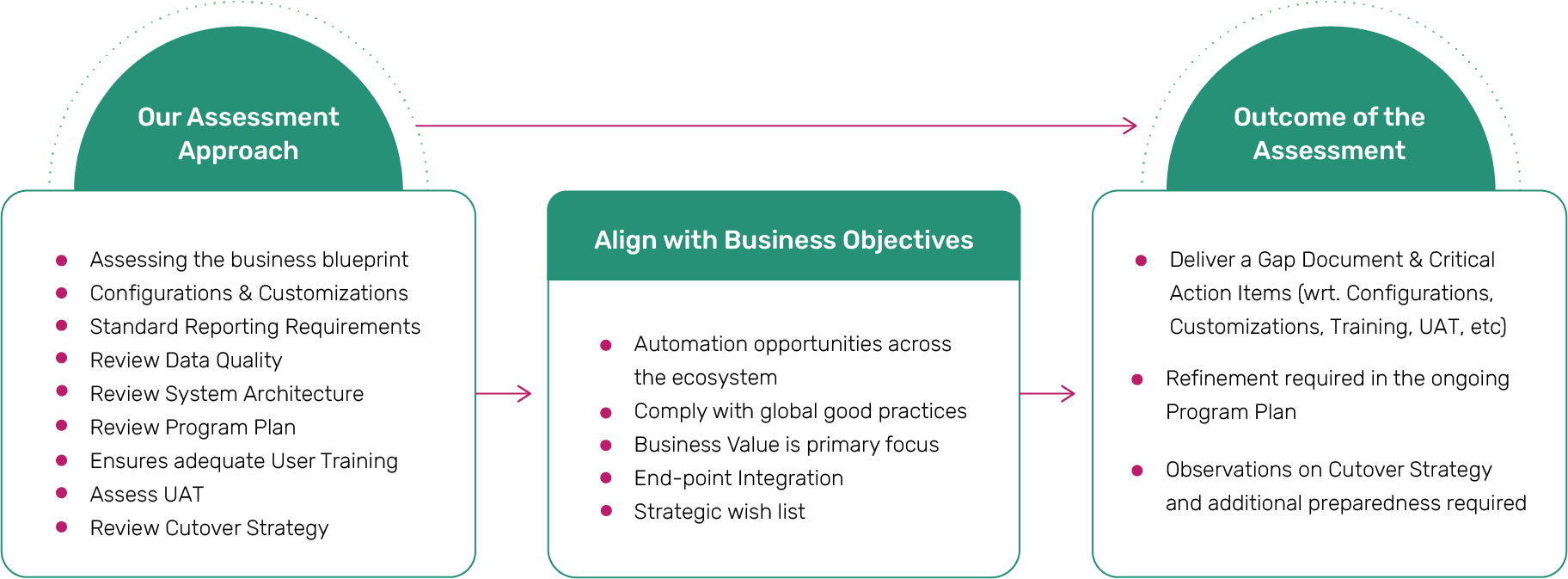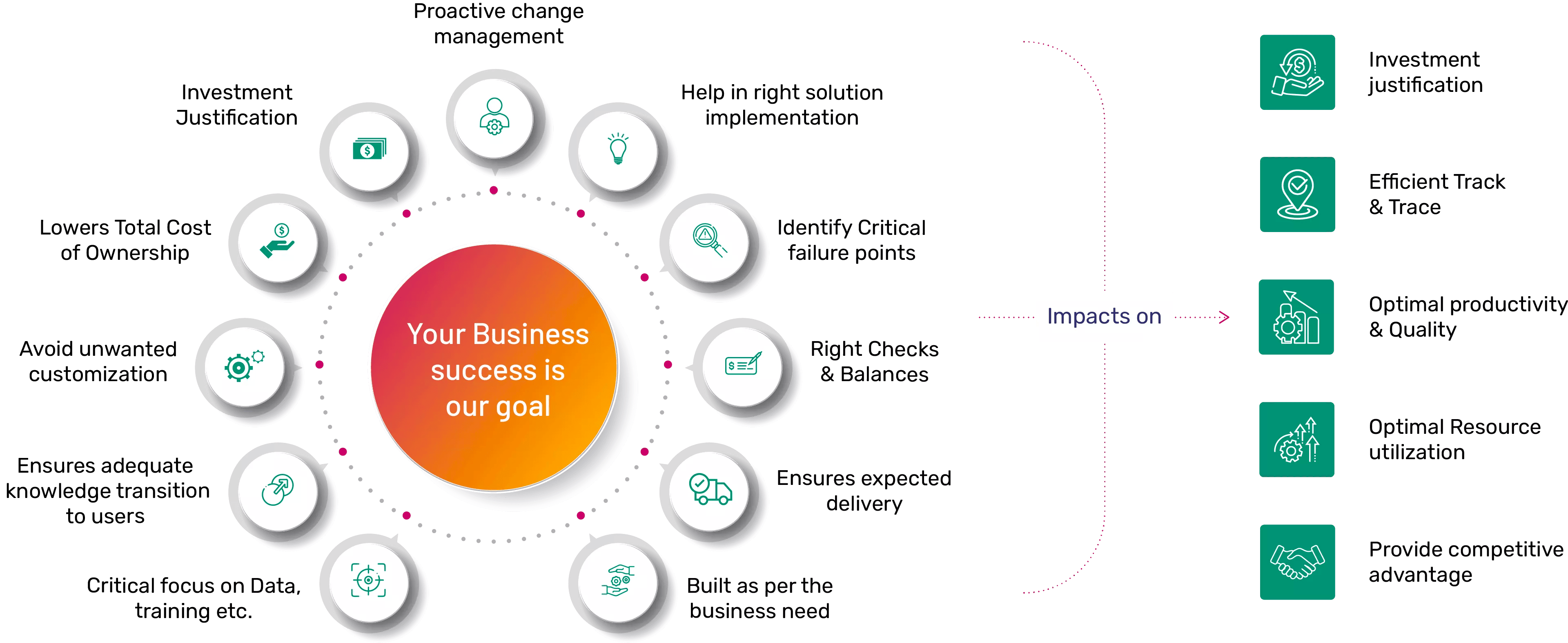Quality Assurance and Independent Program Review is paramount for any large-scale, complex, and successful Microsoft Dynamics ERP implementation. The objectives of Quality Assurance of ERP implementation partners are to identify defects or anomalies, recommend corrective measures and ensure the intended business value delivery. Also, it gets the program back on track and helps in saving time & budget.
It is never too late to bring the project on track with the required expert team either to work with the current Microsoft Dynamics ERP partner or take over the project and deliver.
No matter what challenges you’re facing, there are ways you can rescue your ERP implementation project by seeking help from a Microsoft Dynamics ERP implementation partner. Here is how:
When faced with delays in completing a Microsoft Dynamics ERP implementation project, it is important to take appropriate actions to mitigate the situation. So, you need to:
Identify the root causes: Conduct a thorough analysis to identify the specific factors contributing to the delays and address them accordingly.
Revisit the project plan: Review the project plan, milestones, and dependencies to ensure they are realistic and achievable. Make necessary adjustments to accommodate the delays and establish a revised timeline.
Prioritize tasks: Identify essential tasks or milestones that have the highest impact on the ERP project’s success and focus efforts on completing them promptly.
When your business processes aren’t demonstrated after ERP configuration or customization, it can lead to confusion, inefficiencies, and challenges in using the system effectively. Here are some steps to address this issue:
Identify the Gaps: Assess the gap between the configured or customized ERP system and the actual business processes. Identify areas where the system does not align with the desired workflows or where there are missing functionalities.
Engage Stakeholders: Involve key stakeholders, including process owners, end-users, and IT personnel, in the discussion. Understand their requirements, challenges, and expectations regarding the ERP implementation system.
Review Documentation: Evaluate the existing documentation, such as process flowcharts, user manuals, and system configurations. Ensure that the documentation accurately reflects the configured Microsoft Dynamics ERP system.
Address Configuration or Customization Issues: Bring in ERP experts providers for the modules or processes and identify the issues and plan for corrective action. This may involve reconfiguring the system, customizing certain functionalities, etc.
Address the Change Management Issues: Some of the processes may have to be handled in a different way and the users have to be trained or their roles and responsibilities need to be reviewed or aligned to the new processes or system processes.
Documentation and User Guides: Provide comprehensive documentation and user guides that explain the various processes involved in the ERP implementation system. This documentation should be easily accessible and understandable, offering step-by-step instructions and explanations for each process. It can include screenshots, diagrams, and examples to illustrate the steps effectively.
Training Programs: Conduct training sessions or workshops to educate users about the ERP implementation processes. These sessions can be conducted by our experienced Microsoft Dynamics ERP professionals who are well-versed in the system’s functionalities and processes. Hands-on training with real-life scenarios can help users grasp the processes more effectively.
Continuous Communication: Maintain open lines of communication with users and encourage them to provide feedback on their understanding of the ERP implementation processes. Regularly gather feedback to identify areas where users are struggling or require further clarification.
If the User Acceptance Testing (UAT) results for an ERP implementation are not satisfactory, it indicates that there may be issues or discrepancies between the expected functionality and the actual performance of the system. Here are some steps you can take to address this situation:
Analyze the Test Results: Review the UAT results in detail to identify specific areas where the ERP implementation system did not meet the desired expectations. Determine the nature and severity of the issues encountered during testing.
Debug and Fix Issues: Work closely with the Microsoft Dynamics ERP solution provider or implementation partner to address the identified issues. Collaborate with technical experts, consultants, or support personnel to investigate and resolve problems. This may involve code fixes, configuration adjustments, or data corrections.
Retest and Validate: Once the identified issues have been addressed, conduct retesting to verify that the fixes have resolved the problems effectively. Test the impacted functionalities and associated workflows to ensure they are now functioning as expected.
If users lack confidence in using the ERP system, it’s important to address their concerns and provide them with the necessary support and training. Here are some steps you can take to help build user confidence:
User Training: Conduct comprehensive training sessions for users to familiarize them with the Microsoft Dynamics ERP implementation system’s functionality, features, and processes. Customize the training to meet the specific needs of different user roles within the organization. Provide hands-on exercises and real-world examples to ensure users gain practical experience in using the system.
Involve technically sound people: Engage technically competent employees to provide extensive training and mentorship to others who might be struggling with the ERP implementation system. It can be an effective approach to building confidence and improving user proficiency.
User Feedback and Improvement: Encourage users to provide feedback on their experience with the ERP implementation system. Actively listen to their suggestions and concerns. Use their feedback to drive continuous improvement, address pain points, and enhance the user experience.
If a customer has lost hope in the Microsoft Dynamics ERP implementation, it’s crucial to address their concerns and work towards rebuilding their confidence. Here is how:
Evaluate the implementation: Conduct a thorough evaluation of the Microsoft Dynamics ERP implementation process and assess if there have been any gaps or shortcomings. Identify areas where the implementation may have fallen short of the customer’s expectations or requirements.
Set Realistic Expectations: Set clear and reasonable expectations with the customer regarding the resolution of issues and the future performance of the ERP implementation system. Be transparent about the limitations of the solution and communicate any potential challenges or constraints.
Take over the project: If the customer is seeking a complete change in the Microsoft Dynamics implementation partner, you can propose taking over the project directly. In this case, you would assess the current status of the ERP implementation, evaluate the existing system, documentation, and processes, and develop a detailed plan for the remaining work. This approach may involve knowledge transfer, understanding the project’s history, and working closely with the customer to align the project with their requirements.







